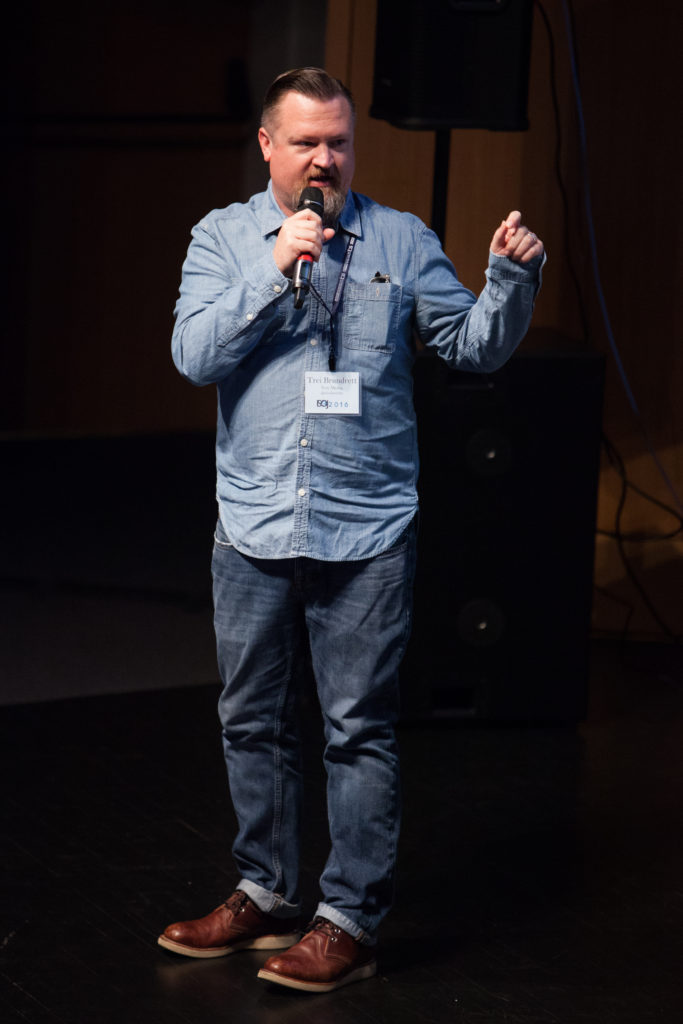Bots and messaging applications continue to evolve, meeting the audience where they are, say experts at ISOJ panel
People in creative industries, including the news media, have become increasingly excited about the future of bots and messaging applications and how they might be used to meet audiences in the digital spaces where they spend their time, heard the audience at the International Symposium on Online Journalism (ISOJ) on Saturday, April 16.
Just the day before the panel titled “Messaging as a platform and bots as a news service” was held at ISOJ, Ian Paul with PC World wrote that 2016 is “turning into the year of the bots,” in addition to the year of virtual reality.

Major companies are putting weight and resources behind bots and messaging applications. Microsoft launched a Bot Framework to help create chat bots and Facebook released a beta version of its Messenger Platform with bot integration.
During the ISOJ panel, five people involved in the development of bots and messaging applications shared their experiences and ideas for uses in the journalism industry.
“Right now, there is a lot of hype about this space,” said Trei Brundrett, chief product officer at Vox Media and panel chair.
As it became clear during Saturday’s talk, defining that space is a challenge of its own.
Ben Brown, co-founder and CEO at XOXCO, neatly defined bots as services and information that are triggered by users and delivered through messaging.
His company created a bot called Howdy that works inside the messaging platform Slack. Howdy is programmed to ask employees a set of questions through Slack. The bot then aggregates the answers into a document that Brown said helps to save time that can be spent on other projects.
Another bot that found a home in Slack was The New York Times Election Bot. Alastair Coote, former mobile editor of interactive news at The New York Times who is now mobile developer at the Guardian U.S. mobile innovation lab, detailed the challenges his team experienced when the experimental project was accidentally released earlier this year.
Slack users could add the bot to their channel and have election results delivered through the platform. Additionally, users could submit questions with the command /asknytelection.

The project was ultimately shut down, but not without imagining ways to improve and use it in future varied contexts.
The team encountered some problems, in particular with timing — primaries wrap up at night but workers generally use Slack during the workday — and also, with specificity: it is impossible for bots to anticipate all the detailed and limitless questions that readers may submit.
Yet, while bots can be automated and incorporate artificial intelligence, humans can also be behind bots, as in the case of Rebecca Harris’ politics-focused Purple, which is centered on “conversational pieces of content” distributed via text.
Harris explained that instead of writing a more traditional article, she thinks about a story in terms of how she would text it to a friend or explain it in a conversation. She breaks down the content into itemized bits of conversation and uses capitalized keywords that users can respond to in order to see the next piece of information.
“Most of how we consume content right now is passively so this is really powerful,” Harris said.
Purple is not only engaging users through conversation. As Harris said, “The key to success is going where the users are, not making them come to you.”
Launched in November 2015, the project has a few thousand users, the average texting 13 times a week.
For other panelists, creating a conversation with readers led to the development of an independent messaging app. In February, Quartz launched an iPhone app that veers from the model of simply listing story headlines as notifications.
The news itself is sent in a message and appears on the user’s lock screen. If interested, the user clicks and is then presented with keyword buttons that will send them to the next bit of information.
Like the other panelists, the Quartz team has used a combination of automation and humans to further conversation.

Zach Seward, vice president of product and executive editor of Quartz, said the average daily active user of the app visits twice a day and uses the program for about five minutes.
Alex Swan, developer at BreakingNews.com/NBCUniversal, explained how his company’s app for iPhone uses location to deliver proximity alerts, including notifications about emergencies, accidents, etc., to nearby users. The news service has also integrated with Slack, even allowing users to follow channels on specific topics.
As they are further developed, bots and messaging applications will likely generate more debate about best practices, ethics and accountability, just as other technological advances before them.
In the mean time, the panelists will continue refining their messaging and content. And some, like Brown, are creating kits to help others create their own bots.
On the subject of authoring these bot platforms, Brown noted their rapid popularity and adoption: “Six months ago this was a crazy idea and now it’s like everybody’s doing it.”
The 17th ISOJ was held April 15-16 at the Blanton Museum of Art on the campus of the University of Texas at Austin. Video from both days can be found here in English, and here in Spanish.
The 18th annual ISOJ is scheduled for April 21-22, 2017, in Austin, Texas.
ISOJ 2016: Messaging and Bots Panel, from Knight Center on Vimeo.

